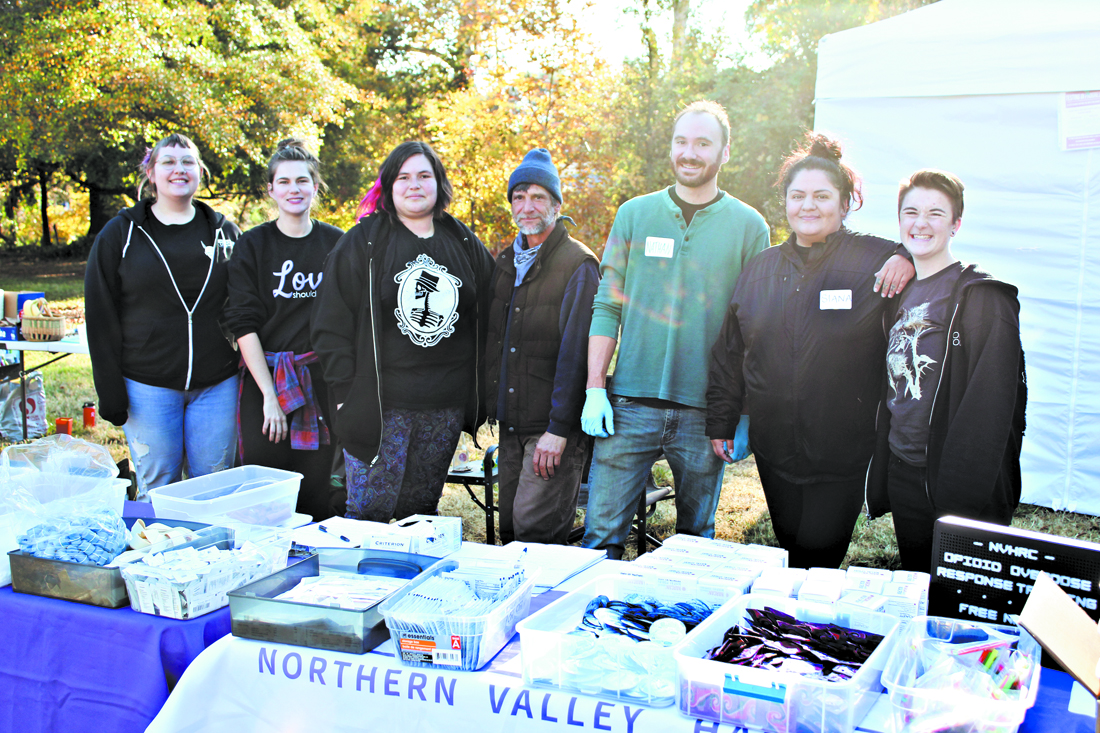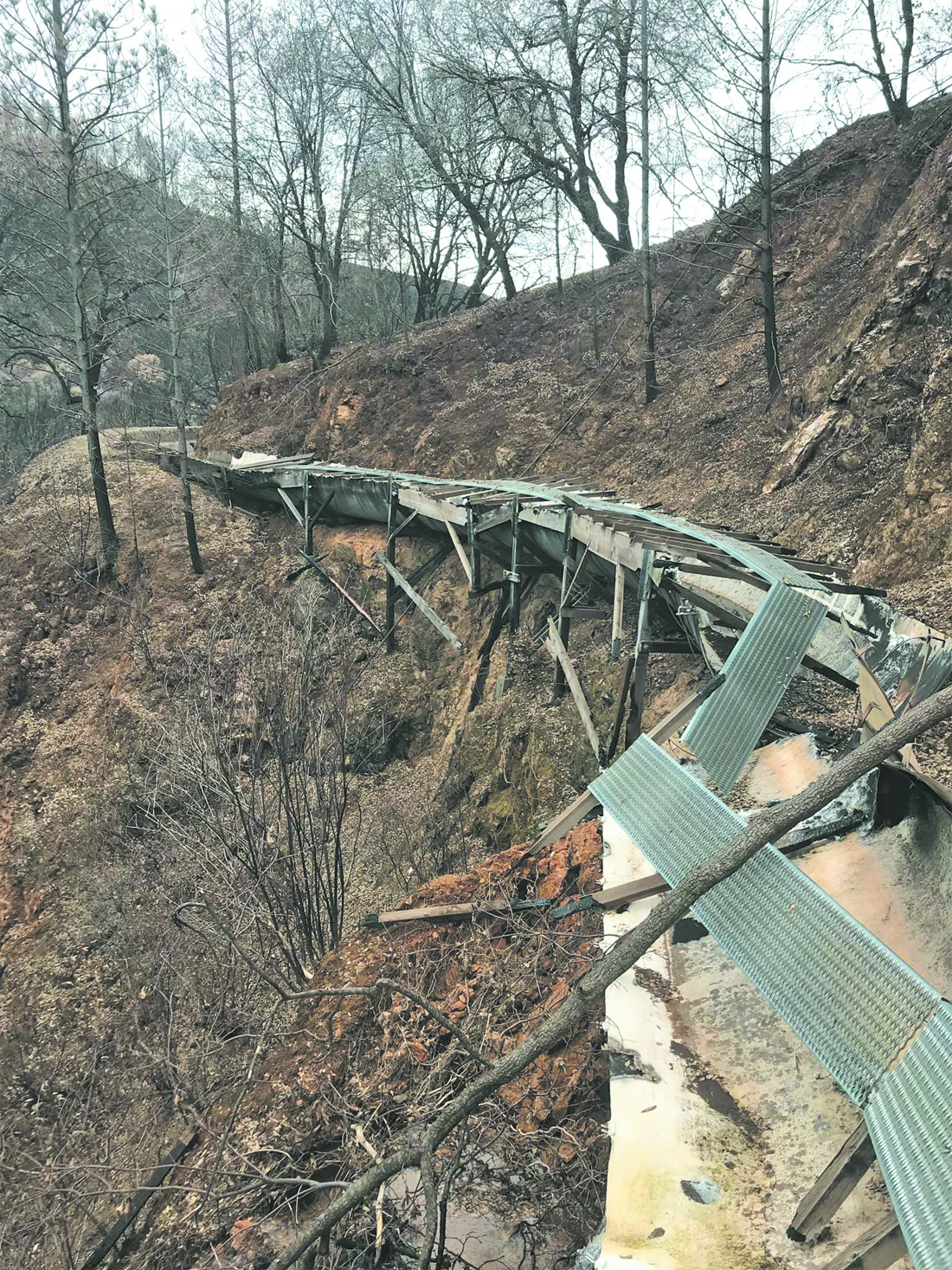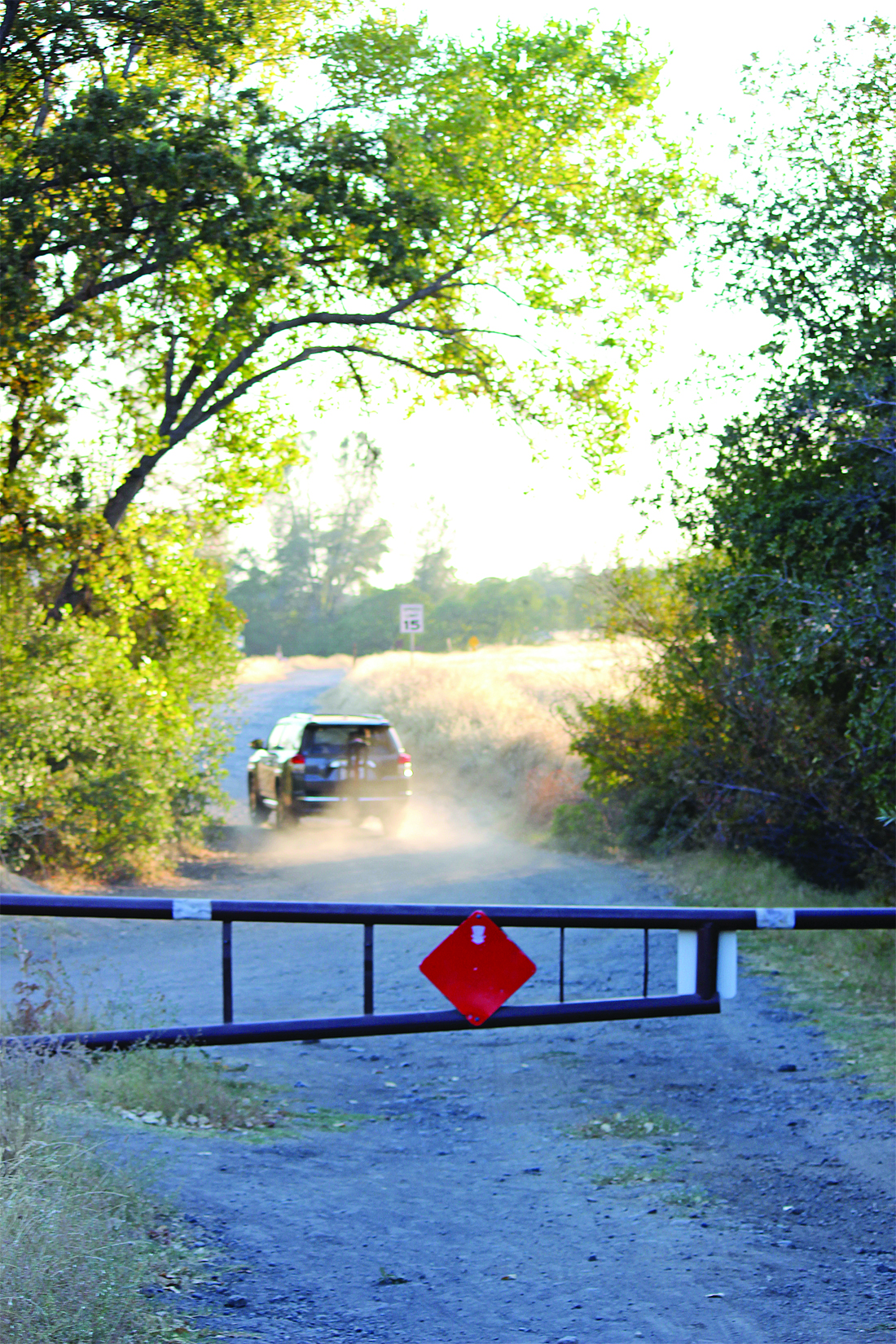
CN&R File Photo
The volunteers of the Northern Valley Harm Reduction Coalition, which received a license to distribute sterile syringes this year, set up their services in Humboldt Park.
Chico State's grand ideas
A hotel and convention center across from Children's Playground in downtown Chico? A sports arena and 900-space parking structure off Warner Street? Several new student housing projects on Chico State's campus?
In a sweeping revision to the university's master plan undertaken this year, all could become a reality over the next three decades.
The update, which was led by Mike Guzzi, the university's associate vice president of facilities and capital projects, has been billed as bringing Chico State into a new era focused on housing, health, academics and sustainability.
The plan, however, drew concern. The Chico Avenues Neighborhood Association questioned the potential traffic impacts related to the aforementioned arena and parking structure, and it objected to the proposed facilities on principle, citing previous transportation studies conducted by the school.
Chico State President Gayle Hutchinson told the City Council in September that the updated master plan was expected to go before the California State University board of trustees for approval in May 2020.
Fentanyl overdoses in Chico
Fentanyl—the powerful synthetic opioid that police said was more commonly linked to overdoses in Eastern states than Western ones—was attributed to the death of a father in a suburban Chico neighborhood early this year.

Photo courtesy of Scott C. Shaw
A destroyed section of the Upper Miocene Canal east of Adventist Health Feather River Hospital off of Pentz Road in February.
Police and medics responded on the morning of Jan. 12 to a mass overdose incident at a home on Santana Court near East Avenue. More than a dozen people were hospitalized, and first-responders administered multiple doses of the drug Narcan to revive people suffering from the effects of an apparent opioid overdose.
One man—34-year-old Aris Turner of Chico—died. Police said partygoers had ingested a combination of fentanyl, cocaine and methamphetamine, and without the overdose-reversing medication, the outcome could have been much different.
The incident brought more national attention to a region already dealing with the effects of the Camp Fire.
Dried up
When the Camp Fire tore through the Ridge in November 2018, it also destroyed the uppermost portion of the Miocene Canal (better known as the Paradise flumes)—a major water conveyance system for Butte Valley residents, many of whom are farmers and ranchers. PG&E owns the canal and has contracts with water users downstream. In April, an advocacy group of water users called the Miocene Canal Coalition aired their grievances before the Butte County Board of Supervisors. The dry canal was jeopardizing their livelihood, they argued, posing a fire risk and causing native habitat to disappear. The county then hosted a series of meetings between the utility and water users to forge a path forward.
But progress was slow: PG&E would not commit to repairing the system, citing an estimated $15 million cost. In July, the utility began delivering 5,000 gallons of water per week to its users, but the amount is just a fraction of what's needed to sustain agricultural operations. In November, Bamford Family Farms announced it was shuttering its operations—the first business to do so because of the dry and damaged Miocene. The coalition eventually decided to seek redress legally.
Bridge builders
Not long after the twisted remains of the Honey Run Covered Bridge were pulled from Butte Creek after the Camp Fire, an effort to rebuild the historic county icon in Butte Creek Canyon began in earnest.
The cause, which largely has been spearheaded by the folks at the Honey Run Covered Bridge Association (HRCBA), with President Robert Catalano at the forefront, reached several milestones this year. The association raised more than $600,000 in cash, pledges and materials toward the rebuild, which has been estimated to cost about $3 million. A preliminary foundation analysis was completed at the bridge site, and ground was broken on a new caretaker's cottage at the adjacent park.
Looking ahead, the HRCBA believes construction on the bridge's foundation could begin next spring, and talks remained ongoing for the association to take ownership of the bridge and extend the park grounds across the creek.
Enrollment down

Chico State and Butte College were not immune to the effects of the Camp Fire. Students and faculty alike lost homes during the disaster, and many suddenly faced daunting commutes while living on couches and trying to navigate disaster relief programs, insurance claims, and other tasks.
When the final enrollment numbers came out, Chico State was down more than 500 students from last school year, and Butte College lost closer to 1,000 students. Luckily for the local campuses, the California State University system and the California Community Colleges Chancellor's Office, respectively, recognized the disaster's impact and offered a temporary reprieve, allocating funding despite the lower enrollments.
Settlement time
Two cases involving civilian deaths at the hands of law enforcement came to a conclusion in court in 2019. The first was the shooting death of 19-year-old Breanne Sharpe in 2013. While leading police on a car chase, Sharpe was shot and killed after she hit a utility pole and put her car in reverse. Five officers who fired their weapons said they feared for their lives. She died on the scene.
Years of litigation ended in early 2019 when an appeals court judge overturned a lower court's decision, agreeing that several of the officers reasonably feared for their lives but that one, then-Sgt. Scott Zuschin, did not. He was the first one to fire his weapon.
Ultimately, the city of Chico settled with Sharpe's mother for $950,000.
In a similar case from 2018, Butte County settled with the family of Myra Micalizio, a mentally ill woman who was shot and killed by deputies inside her car after residents reported she was rummaging through their belongings outside their home in Palermo. Like Sharpe, Micalizio was driving in reverse when officers opened fire. In October of this year, the county agreed to pay her family $250,000.
Managing the forest
In the wake of the Camp Fire, forest management jumped to the top of local, state and national priority lists. While organizations like the Butte County Fire Safe Council had been working steadily to improve the health of our local canopy, they got a big boost in terms of support this past year. The fire safe council, for instance, went from four employees to 11, and it and other groups secured a number of grants to catalog the local landscape and begin work to eliminate fuels.
At a summit meeting earlier this month, stakeholders highlighted the headway made over the past year to work collaboratively, which marked a big step toward developing a comprehensive forest management strategy. Cal Fire reported several large-scale projects to cut back fuels in rural areas of the county. And several nonprofits said they were optimistic about their own projects, from the development of a database tracking local activity to grant opportunities for utilizing wood coming out of the forests.

CN&R File Photo
Mike Guzzi, Chico State’s associate vice president of facilities and capital projects, led an update of the school’s master plan.
Meanwhile, the Mechoopda Indian Tribe, whose ancestral lands stretch from Chico into the foothills, announced a plan to coordinate educational efforts focused on traditional ecological knowledge, including prescribed burning and planting of native trees.
Coming to the ballot
For years, various Chico leaders tip-toed around the idea of proposing a sales tax to the voters. That is, until October of this year, when the City Council voted to put a 1 percent sales tax increase on the November 2020 ballot that would change the rate from 7.25 percent to 8.25 percent.
A sales tax increase has been circulating for the better part of the past decade, most recently garnering the support of the Chico Chamber of Commerce in early 2018.
Why now? One major impetus is the bleak financial outlook for the city, including rising costs and slowing economic growth. City staff noted that, without drumming up increased revenue, the city likely would have to reduce services and staffing. If such a measure passes, the city anticipates an $18 million annual general fund infusion.
Another selling point for the City Council: overwhelming community support. A city-commissioned survey revealed that 70 percent of respondents said they would vote yes on such an increase to fund police, firefighters, roadway maintenance and Bidwell Park upkeep.
Less harm
In 2018, a Chico-based grassroots group of volunteers called the Northern Valley Harm Reduction Coalition (NVHRC) formed to work toward eliminating barriers to treatment for drug users. They began providing free trainings for opioid-overdose response and the use of overdose-reversing drug Narcan, syringe disposal and litter cleanup, and street outreach.
In November, NVHRC added another service to its offerings: providing free, sterile needles. The California Department of Public Health granted the group a two-year license for such a program this October, as research has found syringe access programs to be effective in reducing transmission of HIV, hepatitis C and other blood-borne diseases among injection drug users.
Butte County Public Health officials voiced support for the program along the same lines, presenting their recommendations to the Chico City Council and Butte County Board of Supervisors. Despite the support from the experts, however, NVHRC has received pushback from prominent Chico figures, such as Chico Police Chief Mike O'Brien and Councilwoman Kasey Reynolds—detractors have argued the service is enabling and a threat to public safety.
Housing catastrophe

CN&R File Photo
Long closed to motorists, this gate at Diversion Dam on Upper Park Road will be open two days a week.
While the bidding wars that took place in the immediate aftermath of the Camp Fire have slowed and home prices have stabilized in the past year, renters have continued to be displaced and priced out of the market. In the interest of addressing the crisis, the city of Chico extended its anti-price-gouging ordinance this year, prohibiting rent and hotel/motel rates from increasing more than 10 percent cumulatively from the law's original adoption in November 2018. It'll be in effect for the entirety of 2020. In August, a city ad hoc housing committee began a series of meetings and in September the city hosted a day-long housing conference—for both, the city gathered local experts to brainstorm potential policy changes.
State legislators also worked on addressing the post-Camp Fire housing crunch: In October, Assemblyman James Gallagher's Assembly Bill 430 was signed into law. It circumvents certain California Environmental Quality Act mandates to streamline residential development. (The city of Chico was the only Butte County municipality to opt out, back in May.) Also in October, Gov. Gavin Newsom signed the Tenant Protection Act of 2019, instituting rent increase caps and prohibiting owners from terminating tenancies unless they have just cause (i.e., a tenant is not paying rent or is engaging in criminal activity).
Opening the gate
In December, the City Council made a compromise between calls for accessibility in Upper Bidwell Park and opposition to allowing vehicles to travel to the far reaches of the beloved green space. The panel voted to open the length of Upper Park Road to traffic two days a week and close it another two days a week. The rest of the time, it'll be open to cars up to Salmon Hole.
It was a big deal given access has been a perennial topic for the better part of the decade.
Until this year, discussions about opening the gate at the Diversion Dam—just under the 2-mile mark of the roughly 4-mile road—have been fairly fruitless. In sorry shape after years of storms, much of the unpaved portion of that road has been closed to cars since 2012. Prior to that time, going back to the 1990s, it was closed to vehicles on Sundays and Mondays, as well as the entire rainy season, from Nov. 1 to May 1 (see “Road block,” Cover story, Sept. 22, 2016).
At issue, park administrators have noted, is a lack of funding to properly repair and maintain the infrastructure, as well as the park generally. However, the city recently received about $700,000 from the State Water Resources Control Board to help reconstruct the roadway, from Horseshoe Lake to the end of Upper Park Road.
Meanwhile, questions about how to maintain the green space, including the idea of instituting a parking fee, remain ongoing.
Recovery champions
Butte County is now a year-plus removed from the start of the Camp Fire. In terms of recovery, however, it's become clear over that time that many segments of the affected communities remain in crisis mode.
One of the lifelines has been the nonprofit North Valley Community Foundation (NVCF), which has grown tremendously since the wildfire to aid relief efforts. The Chico-based organization started taking in donations within days of the fire via its Camp Fire Relief Fund and has spent the bulk of 2019 continuing to raise money and award grants to helper organizations and agencies in the region.
In January, for example, NVCF joined forces with Sierra Nevada Brewing Co. and the Aaron Rodgers NorCal Fire Recovery Fund to form the Butte Strong Fund—an effort to pay for larger, long-term rebuilding projects that align with one of its five key focuses: housing, health and wellness, education, community development, and business recovery.
Between the $42.6 million Camp Fire Relief Fund, the Butte Strong Fund and various donor-designated funds, NVCF has raised more than $71 million. Thus far, nearly $30 million via 500 grants has been spent on various recovery initiatives—from addressing food insecurity on the Ridge to paying for counselors for schoolchildren experiencing trauma.
NVCF has indeed been a critical component in the region's recovery and will continue in such a role for the foreseeable future.
